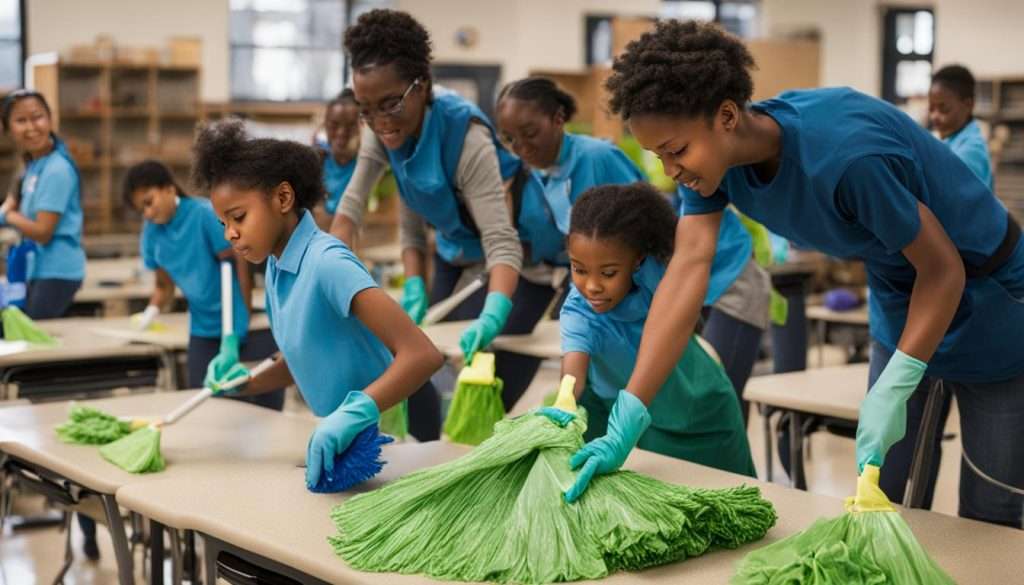
1. Educate Students on the Importance of Cleanliness
Start by educating students about the significance of maintaining a clean school environment. Discuss the health benefits, such as reducing the spread of germs and creating a pleasant learning space. Use engaging methods, such as interactive presentations, videos, or guest speakers, to convey the message. When students understand the impact of their actions, they are more likely to participate actively in cleanliness efforts.
2. Incorporate Cleanliness into the Curriculum
Integrate lessons on hygiene and environmental responsibility into the school curriculum. This can be done through science projects on ecosystems, health education on personal hygiene, or social studies discussions about community responsibility. By tying cleanliness to academic subjects, students can see the broader context and importance of their actions.
3. Establish Student-Led Clean-Up Programs
Create opportunities for students to take leadership roles in cleanliness initiatives. Establish student-led clean-up programs or clubs where students can organize and participate in regular clean-up activities. This could include campus beautification projects, organizing recycling drives, or maintaining specific areas of the school. Providing students with a sense of ownership and responsibility encourages them to take pride in their environment.
4. Implement a School-Wide Recycling Program
Involve students in the school’s recycling program by assigning them roles in managing recycling stations or monitoring waste segregation. Create recycling challenges or competitions between classes to make recycling engaging and rewarding. Educate students about the importance of recycling and how their efforts contribute to environmental conservation.
5. Encourage Peer Accountability
Promote a culture of peer accountability where students remind and encourage each other to keep the school clean. Develop a system where students can recognize and reward their peers for exemplary cleanliness practices. This could include a “cleanest classroom” competition or “spotless student” awards to incentivize and celebrate efforts.
6. Organize Regular Clean-Up Days
Schedule regular clean-up days where students participate in collective cleaning efforts. These events can be part of school-wide initiatives, such as Earth Day or school spirit weeks. Ensure that these clean-up days are well-organized, with clear tasks and roles for each student. Providing proper cleaning tools and guidance helps students understand how to perform tasks effectively.
7. Create Student Cleaning Ambassadors
Designate student cleaning ambassadors or champions who are responsible for promoting cleanliness and organizing activities related to maintaining the school environment. These ambassadors can be selected from various grade levels and can serve as role models for their peers. They can lead initiatives, conduct awareness campaigns, and work closely with school staff to implement cleanliness practices.
8. Foster a Sense of Pride and Ownership
Instill a sense of pride and ownership in the school environment by involving students in decision-making processes related to cleanliness. Allow them to contribute ideas for improving the school’s appearance and participate in the planning of cleanliness initiatives. When students feel that their opinions matter and they have a stake in the school’s condition, they are more likely to engage actively in maintaining it.
9. Use Positive Reinforcement
Recognize and reward students for their efforts in maintaining a clean school. This can be done through verbal praise, certificates, or small rewards. Positive reinforcement encourages continued participation and reinforces the importance of cleanliness. Create a recognition program where students can be acknowledged for their contributions to keeping the school environment tidy.
10. Provide Clear Guidelines and Tools
Ensure that students have clear guidelines on their cleanliness responsibilities and provide them with the necessary tools and supplies. This includes instructions on proper disposal of waste, recycling procedures, and basic cleaning tasks. Providing accessible cleaning tools, such as trash bags, recycling bins, and cleaning supplies, makes it easier for students to contribute effectively.
11. Involve Students in Creating Cleanliness Campaigns
Encourage students to develop and lead cleanliness campaigns within the school. This could involve creating posters, designing educational materials, or organizing workshops on cleanliness and hygiene. By giving students the opportunity to lead and promote cleanliness initiatives, they develop leadership skills and a deeper commitment to maintaining their environment.
12. Integrate Technology and Media
Leverage technology and media to engage students in cleanliness efforts. Create social media campaigns, school newsletters, or digital platforms where students can share their cleanliness achievements and ideas. Utilize school websites or apps to provide updates on cleanliness initiatives and celebrate student contributions.
Conclusion:
By actively involving students in maintaining a clean school, educators can foster a culture of responsibility and respect for the school environment. Through education, leadership opportunities, and positive reinforcement, students become active participants in cleanliness efforts, contributing to a healthier and more pleasant learning space for everyone.